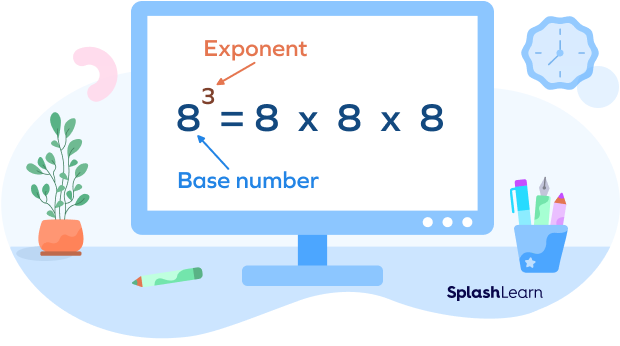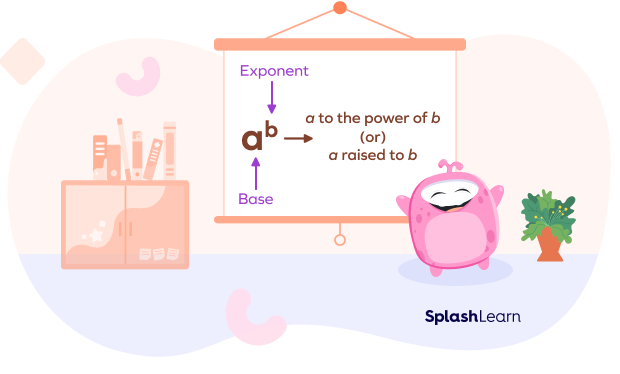Definition of Exponent
The exponent of a number indicates the total time to use that number in a multiplication. For example, 8 × 8 × 8 can be expressed as 83 because 8 is multiplied by itself 3 times. Here, 3 is the ‘exponent’ or ‘power’ which tells how many times 8 is multiplied by itself, and 8 is the ‘base’ which represents the number being multiplied. In short, power or exponent indicates the number of times a number needs to be multiplied by itself. Here, the base can be any integer, fraction or decimal. The exponent can also take up any value, be it positive or negative.

Recommended Games
Examples of Exponent
Here are some examples:
- 54 = 5 × 5 × 5 × 5 = 625
- 35 = 3 × 3 × 3 × 3 × 3 = 243
- 142 = 14 × 14 = 196
- (−4)3 = (−4) × (−4) × (−4) = −64
- $\left(\frac{1}{2} \right)^{4}$ = $\left(\frac{1}{2} \right)\times \left(\frac{1}{2} \right)\times \left(\frac{1}{2} \right)\times \left(\frac{1}{2} \right)$ = $\frac{1}{16}$
- (0.2)3 = 0.2 × 0.2 × 0.2 = 0.008
Recommended Worksheets
How to Read Numbers with Exponents
$x^{n}$ can be read in many ways.
- x to the power of n
- x raised to n
- x to the n
- x to the nth power
There are some special cases:
$x^{2}$ is also read as x square and $x^{3}$ is also read as x cube.

Properties of Exponent
The rules or properties of exponents are used widely to solve various problems. Let us learn about them one by one:
- Law of product
As per the law, to find the product of exponential expressions with the same base we add the exponents. It is given as:
am × an = am + n, where m and n are real numbers
- Law of quotient
As per the law, to divide two exponential expression with the same base we subtract the exponents. It is given as:
$\frac{a^{m}}{a^{n}}$ = am – n, where m and n are real numbers and a is a non-zero term.
- Law of negative exponent
The negative exponent rule states that when an exponent is negative, we can convert it into positive by reciprocating it. It is represented as:
a–m = $\frac{1}{a^{m}}$, where a is a non-zero number and m is a real number.
- Law of zero exponent
As per this law, if the exponent of a real number is 0, then its value is equal to 1, as
a0 = 1.
- Law of power of a product
As per this law, multiplying two different bases with the same power is equal to the product of the base with the power. For instance,
an bn = (ab)n
- Law of power of a power
As per this law, when the power raised to the another power of a base we multiply the exponents. It is represented as:
(am )n = amn
- Law of power of a quotient
According to this law, the division of different bases with the same power is represented as
a$\frac{a^{n}}{b^{n}}$ = $\left (\frac{a}{b}\right)^n$, where b is non-zero term.
Your child must be good at multiplication to solve exponents quickly, so make your child learn multiplication and various other mathematical concepts with ease through SplashLearn Worksheets and various Tutoring Courses for kids of Grades Pre-k to 5.
Fun Facts
- A base with 0 as its power is always equal to 1.
- Any number raised to power 1 is always equal to that number.
- Any power raised to the base 0 is always equal to 0.
- The history of power or exponent is quite old. The term was used for the first time in 1544.
Solved Examples
Example 1: Evaluate 73
Solution:
73 = 7 × 7 × 7 = 343
Example 2: Express the result in exponential form.
23 × 24 × 27 × 2
Solution:
23 × 24 × 27 × 2 = 23 + 4 + 7 + 1 = 215
Example 3: Simplify $\Bigg\{\Big(\frac{2}{3}\Big)^{3}\Bigg\}^{-2}$
Solution:
$\Bigg\{\Big(\frac{2}{3}\Big)^{3}\Bigg\}^{-2}$ = $\frac{2}{3}^{-6}$ = $\frac{3}{2}^{6}$ = $\frac{729}{64}$
Example 4: Simplify the following
(i) 212 ÷ 25
(ii) 33 × 43
Solution:
(i) 212 ÷ 25 = 212 – 5 = 27= 128.
(ii) 33 × 43 = (3 × 4) 3 = 1728
Conclusion
In this article, we have learnt about exponents and their various laws. The exponent of a number indicates the total time to use that number in a multiplication. They are important to write the values of numbers in simplified form.
Read more about exponents and other interesting mathematical terms for children in grades Pre-k to 8 on SplashLearn.
Practice Problems
Exponent
What is the value of (–3)3?
$ −3 × −3 × −3 = −27$
What is the simplified answer of 40 – 20?
40 – 20 = 1 – 1 = 0
$\frac{5^{4}}{5^{2}}$
$\frac{5^{4}}{5^{2}} = {5^{4 - 2}} = {5^{2}} = 25$
Simplify: $4^{−2}$
$4^{−2}$ = $\frac{1}{4^{2}}$ = 0.0625
Frequently Asked Questions
What are the real-life applications of exponent?
Exponents have various applications. A few of them are mentioned below:
- Scientific scales like the Richter scale and Ph scale are based on exponents.
- They are widely used to calculate volume, area, and measurement-related problems.
- They are also used in computer games.
What is the importance of exponent?
Exponents are important to write the values of numbers in simplified form. Repeated multiplication can be simply written with the help of exponents.
What are zero exponents?
Zero exponents are the numbers with 0 as their exponent. Any base with 0 as its exponent is equal to 1.
When can exponents be added?
When exponents with the same base are multiplied, we can add their powers.




















